The Guns of Abacou
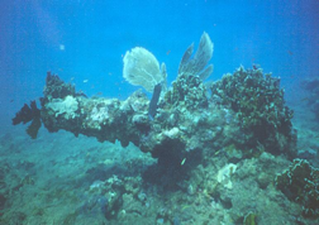
Abacou is a large sandy point of palm treed land, with ancient coral reefs, that jut out into the sunny clear blue Caribbean waters. It lies on the south coast of Haiti, just west of a historic island known as Ile a Vache. The area is one of those ageless places that has beauty, warmth but also reeks of treachery. Abacou provides testament to the New World from the likes of Columbus, Drake, and Sir Henry Morgan who have sailed around this nautical danger. It has seen the towering gilded stern castles of Spanish Galleons float by, glinting golden streaks into the silvery hot sun. For all sailors throughout the centuries it represents a most dangerous hazard that can leap out and swallow you up as is the case of a series of wreck sites lying embedded in the corals of these shallow waters. Wreck sites that, in this present time, want to desperately speak out about world events that happened long ago.
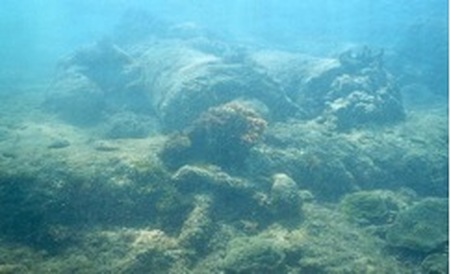
Abacou guards her secrets well. It is such a dangerous area that even for modern day diving, few have ever seen what is hidden there. Some who have tried might venture upon a few things but it takes many days to begin to understand the immensity of this maritime disaster site. The huge swells that come from over 1000 miles away, following the SE trades, keep the average diver at bay. The murky waters that filter out from the mainland also reduce visibility to feet or inches most of the time where a huge gun barrel or the fluke of a massive anchor will leap out at you. A visibility that makes it very difficult to orientate what it is that you have come across. It is not a hospitable place for anyone who wants to explore the many avenues of coral channels. At certain times in the day you can be caught in fast moving currents that are tiring to swim against. At other times you can be popped up the coral walls like a cork from a champagne bottle and find yourself being rolled over razor sharp blade corals to shallower water. That is something I can attest to myself and something I will never forget but Abacou is the type of place that is hard to forget.
In total Abacou has three major areas of interest for someone who is researching Maritime History. All areas seem to be linked to the same time period and nationality, which falls between 1650 to 1720. The most interesting items at this location are anchors and cannon that all seem to be English and all the same design. This fact alone is peculiar, for Haiti was Spanish and then French for centuries. The English were not interested in this island. For around 150 years, Haiti was the richest country in the New World, trading sugar per pound, for more than the price of gold.
Throughout the whole area there seems to be two sizes of cannon and two sizes of anchors. At site B and C there are the same type of broken bottles, lead sheathing and musket balls. In site A and C you find the same type of gunpowder barrels. Gunpowder concreted together from binding corals, long after the wooden staves rotted away leaving the barrel shape. You would think it was all one ship other than there is a total of 11 anchors and 60 cannons. Normally at the most a ship would carry 3-6 anchors so this points to at least 2 ships. The English warship OXFORD was the biggest ship in this area circa 1669, and it carried 36 “heavy” cannon so we know again it must be more than one ship. The English did not have a 60 cannon ship in this area till much later.
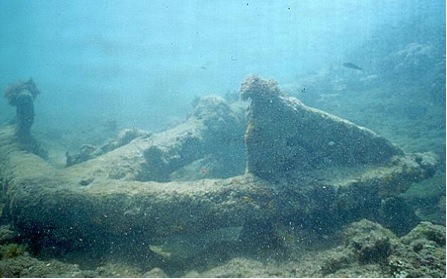
The cannon and anchor count only represents what is found and proven to date. In all areas there are most likely more cannon buried in the wreckage or the coral sand has covered a few. In deeper water it is logical that more anchors will be found. What is not found at all sites is the presence of ballast rock. Nowhere is there a ballast pile or even signs of ballast rock. In a ship of the size involved here there should be many, many tons of round rock. We can only assume the ballast is out deeper and most likely will contain more anchors and cannons. What also is missing is some sort of hull sheathing in any quantity. This sheathing was used to stop the boring toredo worms from turning the hulls in to Swiss cheese and to cut down on the many type of barnacles that would grow on a ships bottom greatly reducing speed. A few pieces of lead sheathing have been located at site B and C but this could be emergency supplies for repairing holes. Normally in sites like these, pieces of sheathing will be found all over with small copper nails that held it on to the hull. But at all sites no quantity of lead or copper sheathing can be found. This could mean the ships had no sheathing at all, which again dates it to English from the 1600s. At this time in history the English did not spend extended times in the Caribbean so they generally did not have sheathing and if they did it was most likely lead. They did not use copper sheathing as a rule until much latter in the late 1700s.
Site A is the location of 11 cannons, 3 anchors, 2 gun powder barrels and other shapes concreted into the coral. All the cannon are the ”heavy” size being over 7 feet in length. The anchors at this site are consistently the biggest of all three sites at about 12 feet long. The cannon are all along the coral wall as if the wreckage floated in and everything tipped and rolled down the deck into the water.
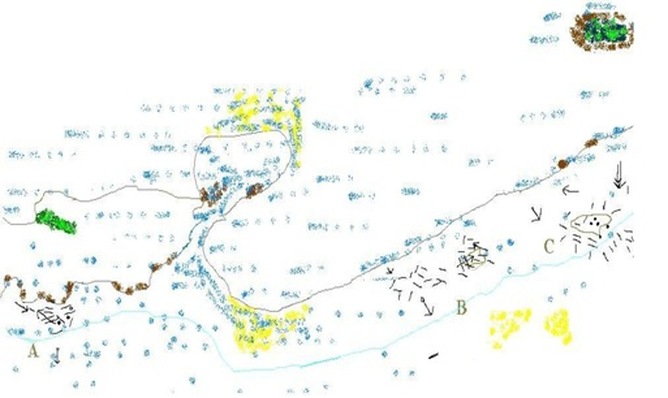
Two cannon are almost buried and there might be several buried under the hard packed coral sand. One anchor is farther out and is set as if it fell off the bow and dug in one final time. It is only in 12 feet of water and no ballast rock is anywhere to be found so this does not represent where the ship floundered. The whole site is in a turbulent area where huge breakers form over top of the wreckage most of the time. It can only be accessed in calm weather and it is most important that the water is clear. All the wreckage is contained in a relatively small area running along the coral wall that is about 6 to 8 feet high. This site does not represent a whole ship. It appears to be a bow section only. No glass fragments, brass pieces, personal items, can be found, which would represent other sections of the ship. From the size of the anchors I would think this was the biggest ship of the three areas of interest. The stern section, mid section, and lower hull are likely out in deeper water. There too you will find more cannons and anchors.
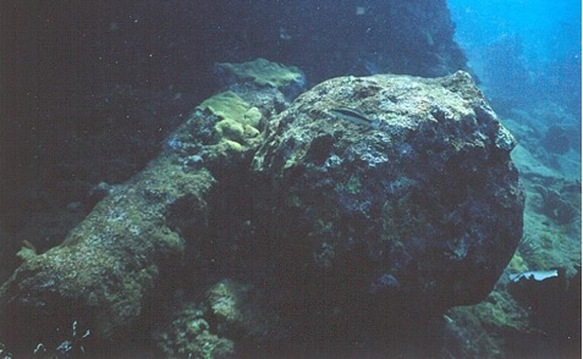
Site B is much father along the reef, almost 1000 feet from site A. You actually have to go against the current and around a slight bend in the reef to go from site A to site B. Site B has 28 cannons and 4 anchors in the area. This site has different sizes of cannon but most are over 7 feet in length. Some more cannon are more than likely buried under the coral cap, which contains a main pile of wreckage. All around this site you will find lead musket balls, glass fragments, lead sheathing, iron pieces, and many other shapes concreted into the coral. The site is again contained to a small area with the cannon all in close proximity. One cannon out to deeper water than the rest, sits in about 12 feel of water while most of the other wreckage is in 6 to 8 feet of water. One broken anchor is in the shallowest area of 4 to five feet. One glass bottom of a bottle at site B is the same as Site C. This site seems to represent a whole ship other than once again no ballast rock or sheathing of any quantity can be found. Even out to 20 feet no ballast is visible. It is as if this wreckage is the main deck of the ship but bottom portions of the hull are elsewhere. No gunpowder barrels are at this site.
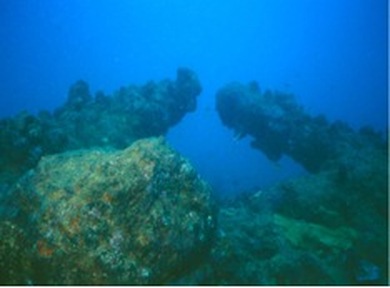
Site C is about 250 feet farther down the reef than site B. It contains at least 21 cannon and 4 anchors. Two anchors are only about 8 feet long representing a smaller ship. This site has two sizes of cannon. The majority are over 7 feet long but there is a variety of 4 foot ones too. It is in about the same depth as site B and again most of the wreckage is contained in a small area. There are likely more cannon under the large coral cap that covers the main wreckage area. This coral cap has started to break up over the last 100 years and some of its contents have fallen out. I have located some brass ENGLISH ROSE furniture ornaments at this site along with some other brass items that are typically English. I would have to think this site contains a stern castle with the Captains quarters. One of the most significant reasons for this thought is the presence of clear plate flat glass. Nowhere at any other site do you find this flat clear glass that was typically used in the stern windows of a stern castle. You also find brass drawyer pulls, pewter pieces, a lead sounding weight, glass bottle fragments, unknown brass pieces, lead musket shot, iron pieces, and much more. I would think this site is a complete ship but again no ballast pile or any quantity of sheathing can be found. The ship must have been smaller than the other two sites due to the smaller anchors and some smaller cannon present on the site. Cemented into the coral cap are at least 5 gunpowder barrels and two have fallen out in front. Around the coral cap much has yet to be discovered as the strong currents limit safe access.
All the sites need further investigation. I have been to Abacou at least 25 times and only 3 times was it really clear enough for a few hours to make sense of the area. The whole area is in turbulent waters and you must dive it at a certain time of day, during a favourable wind and preferably during a certain time in the year. However, all this comes down to being lucky enough in getting a few calms days in a row.
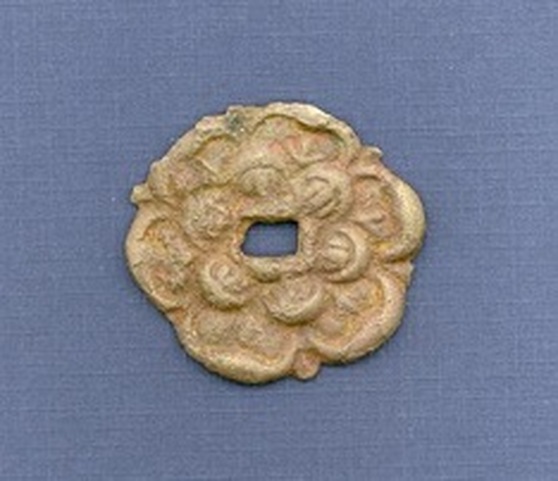
THE CANNONS OF ABACOU could represent the story of the OXFORD. This English warship had just arrived in the Caribbean and it was assigned to Sir Henry Morgan for his campaigns against the Spanish. It had sailed over from Port Royal Jamaica and met up with 12 other ships off Ile a Vache. Mysteriously during the evening of January 2 1669, it blew up at anchor during a party after a war council called by Sir Henry Morgan. In a letter dated in 1670 the disaster is listed as “gunner error”. Over 200 men perished and most likely other vessels around her blew up or burned as well. This story relates to Abacou wreckage in that it is the right nationality, the right vintage and the wreckage seems to speak of an explosion, with ships burning and some wreckage floating in to shallow water. On the night of the explosion it only makes sense that other ships were tied up to OXFORD as they were partying after a war council and OXFORD was a much bigger ship. The next day it was reported they where sailing to Cartagena Columbia and many knew this could be some of their last days. It is also reported after the disaster that Sir Henry Morgan had lost about 40% of his men and several ships where no longer available. It is said 200 to 300 men perished because of the explosion and the OXFORD would have had a crew of around 150, so what ship were these other men from? Most likely from ships rafted up to it.
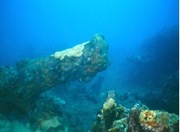
If it is not the OXFORD story what is it? The only other known ENGLISH war ship lost in this area was the H M S SALISBURY in 1796 but this ship most likely would have had copper sheathing and she only carried 50 cannon and several items found at this site have been dated from 1650 to 1720. What other story would relate to 2 or 3 English ships lost at once? Why were these ships not salvaged? Did sharks move in due to so much blood in the water and keep salvagers at bay? Was this a maritime gravesite with crews not wanting to trespass? The site is definitely more than one ship and most likely three. It seems to be three from the late 1600s, which points directly at the OXFORD story but also at another known piece of history.
In October 1670 in a letter to the Governor General of Jamaica, Sir Henry Morgan relates that 12 ships where blown ashore in a storm and 3 could not be re-floated. The position of these three wrecks and all in the same time period suits this wreckage the best. This would also mean there should be other anchors around as these ships, if blown off their anchors most likely broke some anchor lines and left a few in place. You can find some anchors off Ile a Vache - embedded into the ground and now cemented in with coral. Are these from these wrecks? It suits the fact that the anchors are right across the bay from the wreckage. It actually seems very possible the 3 wrecks off Abacou speak of ships being blown across the bay in a hurricane and foundering on the coral reef. Ever since then the high energy area has kept people away due to the dangerous waves, currents and fast currents.
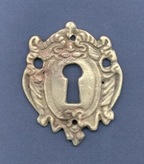
In 2001 our expedition spent over $300,000 US looking for the OXFORD. The area was thoroughly combed where history says she was lost but nothing at all was found there. So where is she? The Abacou site is the only area where the 36-gun OXFORD could have sailed in and taken up a defensive position to avoid being trapped by the Spanish. It is only a few miles from where our “history books” say it was lost. In this new area of interest the trade winds and current would all assist her quick escape to the sea. The Spanish could not sneak up from one whole quadrant, as the trade winds would not allow it. Considering these factors it is the most logical location for a ship to anchor for a few days but still close to other much smaller ships at Ile a Vache for a war council. Fresh water was available from two locations and fresh meat available from Ile a Vache.
What needs to be done is locate the ballast piles. What also is needed is to drag a magnetometer for several weeks trolling off Abacou in deeper water and chartering finds on a grid. There is a specific target area I believe where this wreckage is from and the area would have been very visible from any crows’ nest during the 1600s. You can be sure when they sailed in they would want to be shallow enough to bring some comfortable calm waters to rest in but still deep enough for escape. There is a large bay with direct access to the sea, where I believe these ships were anchored. After an explosion the tide and trade winds could have carried the wreckage right to its present location or a hurricane drove it there. More likely it was the power of a hurricane Morgan described that led to these 3 wrecks off Abacou.
The CANNONS OF ABACOU is an interesting story no matter what wrecks they are from. The whole area is fascinating. Cannons sticking up at the oddest angles and all the colourfull fish swimming around. Anchors lying on the bottom hinting at all the ports they saw before their last drop into the sea. It is a historic area that has seen so very few divers. Artefacts are simply lying on the bottom waiting to help identify these ships. It is a site that people dream of finding to explore and to pin their hopes of finding “treasure”. Unfortunately some divers have already looted cannons and actors from the site and I am sure much more. It is a piece of history waiting to be understood so to unlock the secrets of this time capsule. It is an underwater museum waiting to be developed. It is Haitian History needing to be developed in a proper manner for the benefit of its people. It is in the boundaries of the proposed ILE A VACHE MARINE PARK.
Someday the pounding surf will let the story be told. Someday people will see and understand the history here. Someday the CANNONS OF ABACOU will report again to the world that they are not forgotten. Splitting the air with a concussion of history that is deafening to the living who really want to listen.
Written by Bruce Leeming
Written by Bruce Leeming

